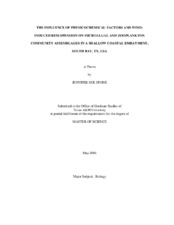| dc.description.abstract | Plankton communities are important members of the food web in coastal systems
and are regulated by top-down and bottom-up controls. This study examined the
influence of bottom-up controls, such as physicochemical factors, and top-down
controls, such as predation, on the plankton communities in South Bay, Texas.
Microalgal photopigments were ascertained by high-performance liquid chromatography
(HPLC) to determine the relative abundances of major algal classes. Zooplankters were
identified to the lowest possible taxon and enumerated. No spatial trends were observed
for the physicochemical factors. The northern bay sections exhibited significantly
higher phytoplankton and microphytobenthic diatom biomass, probably due to their
proximity to the bay inlet. Copepod, gastropod veliger and brachyuran zoea abundances
were also higher in this area, albeit insignificantly. The southern bay sections
experienced significantly higher cyanobacterial, euglenophyte and chlorophyte biomass,
and polychaete larval abundances. Total zooplankton and nauplii abundances were also
higher in the southern areas, albeit insignificantly. Sampling the inaccessible areas of
the bay in the future may reveal spatial variability among the physicochemical factors
which could be influencing the distribution of plankton. Temporal variation for the
physicochemical factors followed a typical trend for subtropical climates and influenced
the seasonality of the plankton communities. Phytoplankton biomass peaked in
February, August and October but these maximums were not significantly different from
the other months sampled. Microphytobenthic biomass peaked during the summer
months, while diatom biomass also peaked in February. Zooplankton abundances
peaked in October, while nauplii and polychaete larvae also peaked in February. Relationships between wind speed, turbidity and the microalgal pigments were assessed
to determine if wind-induced resuspension influenced the location of the major algal
classes within the water column compared to the sediments. Wind speed and turbidity
were directly related to each other, albeit insignificantly. Some phytoplankton and
microphytobenthos were considered tychopelagic because wind-induced resuspension
increased their biomass in the water column compared to the sediments. The
physicochemical factors exerted bottom-up control of plankton community dynamics in
this study, while top-down controls, such as predation, require further investigation.
Future studies should focus on which of these controls have more influence on plankton
community dynamics in South Bay. | en |


